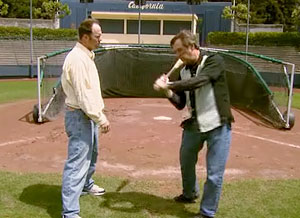 Dave Barker of the Exploratorium
Dave Barker of the Exploratorium
gets some batting tipsWhen I think of baseball and science, I always remember poor Sammy Sosa. In 2003, he was suspended from seven games with the Chicago Cubs for using a bat that had cork in it--an illegal move, according to Major League Baseball rules. I certainly don't feel sorry for him for cheating (though he claims it was accidental), or for having to warm the bench for a while. But I do pity him for making a maneuver that probably never would have helped him anyway.
The idea behind "corking" a bat is that the bat will be lighter and the batter will be able to swing it faster, hopefully imparting more power to the ball. If you watch QUEST's TV feature on the physics of baseball, you'll see my Exploratorium colleague David Barker learning from the CalBears batting coach that getting the bat going fast is a key to whacking the ball as far as possible. In fact, today's players use bats that are lighter and shorter than the ones swung decades ago, for just this reason.
Unfortunately for Sammy Sosa (and others before him who pulled the same stunt), corking the bat to make it lighter is a flawed approach. A wooden bat is a close-to-perfect swatting tool: it's solid enough to resist absorbing much impact from the ball, but not so hard that it overly deforms the ball when hitting it. A bat with cork in the middle will be squishier, and won't hit the ball as hard. Imagine the difference you'd expect if the bat were made of pillows. That's a little extreme, but you get the idea. According to a recent Mythbusters show, corked bats don't improve the power of a hit.
See for yourself what a difference swing speed can make. Check out our online "Scientific Slugger." You can choose different swing speeds and pitches, and see which combinations go farthest (if hit perfectly).
Did Sammy know he was swinging a corked bat the day he was caught, or was it truly an accident? We'll probably never know. But what's clearer is that, in terms of a baseball career, it probably wasn’t worth the risk.
